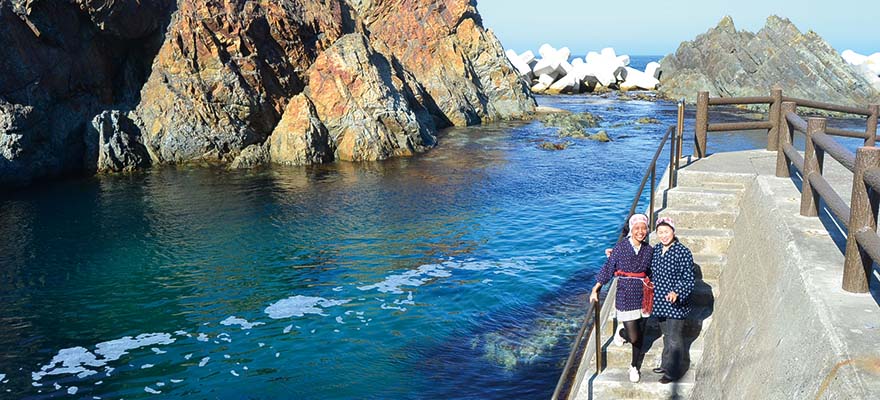Home > Highlighting JAPAN >Highlighting Japan November 2013>40th Year of ASEAN-Japan Friendship and Cooperation
Highlighting JAPAN
47 Prefectures from A to Y
Iwate
A Visit to Kuji and Tōno

Thanks to the recent morning television NHK drama 'Ama-chan'(diving girl), set in Kuji City (the fictional Kitasanriku), Iwate Prefecture has been in the news a lot. In search of our 'diving girl' heroine we took the Tohoku shinkansen to Ninohe and then a local bus to Kuji station. On the way, scenery of woodland, freshly harvested rice fields, steep cliff faces and rock-strewn rapids welcomed us.
Inside a new and architecturally pleasing facility, the Dofūkan, we found Kuji's tourist office, a display of one of the huge floats used in the city's Fall festival, some Kokujiyaki (traditional pottery from Kuji) and numerous small shops selling local produce.
After a meal of fresh fish and locally-grown rice in 'Retro Square', next to the Dofūkan, we made our way up to Tatsumiyama park for a great view of the city and the sea.
A trick to travel around here is to use taxi drivers: in Kuji they are willing to drive visitors around for a set time and a small fee. Thanks to this, we arrived quickly at the Kosode Kaigan (Kosode Coast), where the Ama Center (diving women's center) is located. On the way awaits a spectacular view of the rias coastline; the weathered Tsuriganedō is of particular note.
Next to Meoto-iwa, a pair of rocks symbolizing a husband and wife linked by a sacred shimenawa, is the ama diving area. Wearing the characteristic blue tunic and shorts, snorkel, yakkari (net) and soegaki, ama dive among the rocks and crevices searching for sea-urchins and other shellfish, which they scoop up and place in their nets.
Back in Kuji is also the amber museum, showcasing local geological history, amber exhibits and a former amber mine. It is even possible to visit a local quarry and dig for amber yourself.
For enthusiasts of folk culture, Tōno City, to the south of Kuji is well worth a visit. The city became renowned for its folklore thanks to Kunio Yanagita's Tōno Monogatari (Tōno Story), published in 1910.
There are many interesting places here, but we decided to focus on the Kappa Buchi or 'Kappa Pond' and the Chibake Magariya (Chiba family home). We rented bicycles and set off for Jōkenji Temple, where Kappa Pond is located.
The temple lies along a country lane adjacent to the entrance of the old Mount Hayachine path. Walking through the temple grounds, a small wooden bridge spanning a gently meandering freshwater stream marks the entrance to Kappa Pond. A gravel path follows along the stream to the pond, actually a section where the stream widens. While enjoying the bubbling sound of the water and view of the fish that dart along the streambed, visitors are invited to see if they can catch a kappa using a bamboo fishing rod to which a cucumber (a favorite food of kappa) is attached.
8km to the west of Tono is found a treasure of traditional Nambu architecture, the Chibake Magariya, named from the Japanese 'magaru', 'to bend' in reference to the characteristic L-shape of the layout. In times past, horse stables were in the foot of the L-shape and raised living quarters in the main body of the L. The doma, or 'earthen floored room', in between the two sections was used as the kitchen and main work area. Similar in construction to a small castle, the magariya affords splendid views of the surrounding hills, largely unchanged since times past.
Iwate, with its national parks, World Heritage and traditional folk culture, coupled with the honesty and warmth of the locals, is a recommended stay for any traveler.
© 2009 Cabinet Office, Government of Japan






